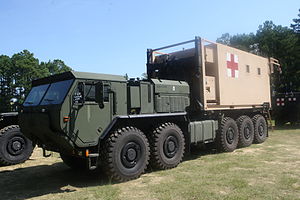Mobile Trauma Bay
Mobile Trauma Bay is an innovative healthcare solution designed to provide immediate, advanced medical care in environments where traditional hospital facilities are inaccessible or overwhelmed. This concept is particularly relevant in scenarios such as military operations, disaster zones, and remote areas where the rapid delivery of trauma care can significantly affect survival rates and outcomes.
Overview[edit | edit source]
A Mobile Trauma Bay (MTB) is essentially a portable, highly equipped medical unit capable of providing comprehensive trauma care. It is designed to bridge the gap between the point of injury and definitive care facilities by offering critical interventions close to the site of trauma. The MTB is equipped with the necessary medical equipment and supplies to perform a wide range of procedures, from basic life support to more complex surgical interventions.
Components[edit | edit source]
The core components of a Mobile Trauma Bay include:
- Medical Equipment: Advanced life support systems, surgical instruments, blood transfusion kits, and imaging devices.
- Medications: A stockpile of essential drugs, including anesthetics, antibiotics, and pain management medications.
- Personnel: A team of healthcare professionals, including surgeons, nurses, anesthesiologists, and paramedics, trained in trauma care.
- Mobility: The MTB is typically housed within a vehicle or a series of modular units that can be quickly deployed to the site of need. This mobility is crucial for its effectiveness in diverse environments.
Applications[edit | edit source]
The applications of Mobile Trauma Bays are vast and varied, including:
- Military Operations: Providing immediate care to wounded soldiers on the battlefield, significantly improving survival rates.
- Disaster Response: Offering critical medical interventions in the aftermath of natural disasters or catastrophic events where local healthcare facilities are damaged or overwhelmed.
- Rural Healthcare: Serving remote areas with limited access to comprehensive medical facilities, thus bridging the gap in healthcare delivery.
Challenges[edit | edit source]
While Mobile Trauma Bays represent a significant advancement in trauma care, they face several challenges:
- Logistical: The deployment and operation of MTBs in diverse and sometimes hostile environments require meticulous planning and resources.
- Technological: Keeping the MTB equipped with the latest medical technology and ensuring its functionality in all types of environments is a constant challenge.
- Training: Personnel operating within MTBs need specialized training to adapt to the unique conditions and limitations posed by the mobile nature of the facility.
Future Directions[edit | edit source]
The future of Mobile Trauma Bays lies in technological advancements and strategic partnerships. Innovations in telemedicine, portable medical devices, and autonomous vehicles could enhance the capabilities and efficiency of MTBs. Furthermore, collaborations between governments, military, non-governmental organizations (NGOs), and the private sector are crucial for expanding the reach and impact of these mobile units.
Search WikiMD
Ad.Tired of being Overweight? Try W8MD's physician weight loss program.
Semaglutide (Ozempic / Wegovy and Tirzepatide (Mounjaro / Zepbound) available.
Advertise on WikiMD
|
WikiMD's Wellness Encyclopedia |
| Let Food Be Thy Medicine Medicine Thy Food - Hippocrates |
Translate this page: - East Asian
中文,
日本,
한국어,
South Asian
हिन्दी,
தமிழ்,
తెలుగు,
Urdu,
ಕನ್ನಡ,
Southeast Asian
Indonesian,
Vietnamese,
Thai,
မြန်မာဘာသာ,
বাংলা
European
español,
Deutsch,
français,
Greek,
português do Brasil,
polski,
română,
русский,
Nederlands,
norsk,
svenska,
suomi,
Italian
Middle Eastern & African
عربى,
Turkish,
Persian,
Hebrew,
Afrikaans,
isiZulu,
Kiswahili,
Other
Bulgarian,
Hungarian,
Czech,
Swedish,
മലയാളം,
मराठी,
ਪੰਜਾਬੀ,
ગુજરાતી,
Portuguese,
Ukrainian
Medical Disclaimer: WikiMD is not a substitute for professional medical advice. The information on WikiMD is provided as an information resource only, may be incorrect, outdated or misleading, and is not to be used or relied on for any diagnostic or treatment purposes. Please consult your health care provider before making any healthcare decisions or for guidance about a specific medical condition. WikiMD expressly disclaims responsibility, and shall have no liability, for any damages, loss, injury, or liability whatsoever suffered as a result of your reliance on the information contained in this site. By visiting this site you agree to the foregoing terms and conditions, which may from time to time be changed or supplemented by WikiMD. If you do not agree to the foregoing terms and conditions, you should not enter or use this site. See full disclaimer.
Credits:Most images are courtesy of Wikimedia commons, and templates Wikipedia, licensed under CC BY SA or similar.
Contributors: Prab R. Tumpati, MD

